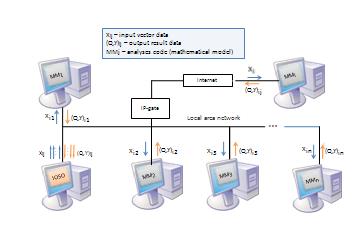|
Parallel optimization
Is your model not well-parallelized? Our new
algorithm of optimization process parallelization works with any model!
 The use of multiprocessor computers
and clusters is one of the prospective trends
improving optimization process efficiency. In this case, the reduction
of elapsed (clock) computing time can be achieved by the parallelization
of the computational model itself, or by adaptive organization of the
optimization process for parallel computations. The first approach
implies the use (or development) of mathematical models or engineering
applications suitable for efficient employing of parallel processors.
The latter makes it necessary to develop or to modify the corresponding
optimization techniques. The use of multiprocessor computers
and clusters is one of the prospective trends
improving optimization process efficiency. In this case, the reduction
of elapsed (clock) computing time can be achieved by the parallelization
of the computational model itself, or by adaptive organization of the
optimization process for parallel computations. The first approach
implies the use (or development) of mathematical models or engineering
applications suitable for efficient employing of parallel processors.
The latter makes it necessary to develop or to modify the corresponding
optimization techniques.
We have developed the new optimization software IOSO PM, which uses parallel
clusters. Our algorithm allows us to reach the speed-up parameter value
that equals the total number of operational CPUs. For example, when using
20 processors we can speed-up the optimization process 40 and more times.
Our algorithms allow for the most efficient usage of existing computational
resources because the number of processors actively involved in solving
the problem is independent of the problem dimension. For example, when
solving a 10 variable problem one can employ from 1 to 100 and more processors.
Our algorithms make it realistic to formulate and solve the optimization
problems even when many hours are required to the response values for
one combination of design variables (for example, 3D CFD codes). Combining
our parallel procedures with our algorithms of multilevel
optimization significantly expands the limits of solvable complex
practical problems.
The main difference between the developed parallel optimization algorithm
and the basic IOSO algorithm is in the information received by the data
analysis and moving strategy unit. This information is not for a single
point only, but for a whole set of points, the number of which is equal
to the number of slave processors. This can affect the algorithm work
efficiency. To evaluate this effect, a testing
of the developed algorithm has been carried out.
Details...
|
